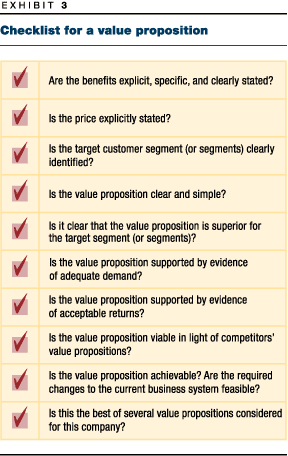A [McKinsey & Company] 1988 staff paper by Michael J. Lanning and Edward G. Michaels combines the value maps developed in the price-value models with the idea of the “business system,” which was introduced in 1980. The paper, “A business is a value delivery system,” emphasizes the importance of a clear, well-articulated “value proposition” for each targeted market segment—that is, a simple statement of the benefits that the company intends to provide to each segment, along with the approximate price the company will charge each segment for those benefits. Lanning and Michaels use value maps for each customer segment to reveal which value propositions are most likely to appeal strongly to specific segments.
…
In “Getting back to strategy,” Ohmae questions the wisdom of a single-minded focus on rivalry and industry structure. He reminds us that the best strategists, though they will not walk away from battles that clearly must be fought, avoid competition whenever they can, and he argues forcefully that strategy should be less about defeating the competition and more about creating value for your customers.
A business Is A Value Delivery System
By Michael J. Lanning and Edward G. Michaels
…
Knowing exactly what customers value enables you to divide potential buyers into segments—groups of potential customers who desire more or less the same product benefits and are willing to pay more or less the same amount of money for them. Once you have a map of all the relevant customer segments, you can assess the opportunities for your business unit to deliver superior value to each. A business unit’s ability to deliver value can vary widely from one segment to another, and the unit will often be able to pursue just one or two segments profitably. That means offering the people in those segments the benefits they desire, at or below the desired price, so that competitors can’t easily match the results. (To test a potential value proposition, go through the checklist given in Exhibit 3.)
Canon’s strategy in the camera market in the mid-1970s provides an example of canny market segmentation. At that time, the market apparently consisted of two segments: the professional-quality segment, whose members were willing to pay over $300 for a camera, and the point-and-shoot segment, made up of those who didn’t mind photos that looked like snapshots and wanted a camera that cost under $100. Canon thought there might be a third category, containing millions of people who sought the quality of a 35-millimeter camera in an easier-to-use form and at a price between $150 and $200. Canon invested heavily in developing and mass-marketing such a camera—the AE1—and the rest is history.
…
Having selected a particular value proposition, you must see to it that this proposition “echoes” throughout the business system to ensure that each activity of the company serves to reinforce the chosen value. New value propositions can certainly lead to a winning strategy, but so can superior echoing of a more ordinary value proposition. The value delivery system is a useful framework for evaluating this echoing process.
Traditionally, managers break down their business systems in production terms. “Step one: create the product. Step two: make the product. Step three: sell the product.” This may be useful for production-side projects such as cost cutting. But if you are trying to deliver a compelling value proposition, it makes more sense to divide up the business system into customer-oriented stages: choosing the value, providing the value, and communicating the value to the customer. A business system thus broken down is called a value delivery system, and in preparing it you should be able to describe the role that each department and employee plays in one or more of these three value-related tasks (Exhibit 5). Only then can you be sure that your chosen value proposition pervades every layer of your organization.
Remember, the winning strategy is often the one that best implements its value proposition, not the one whose proposition has the greatest appeal. Good execution provides its own obstacle to imitation because it is difficult to achieve. If an organization takes the value delivery system seriously, its managers can ask each department to contribute to the chosen measure of value. This may mean that the manufacturing side must compromise its cost-efficiency record to allow for the introduction of a new formula or that the ad agency must develop advertising that communicates the value proposition instead of pursuing some potentially award-winning but irrelevant idea. Each link in the chain will then be less inclined to pursue its own parochial aims and more likely to serve the unit’s overarching goal: adding the right kinds of value for the right customer segments.
About the authors
Harvey Golub and Jane Henry are alumni of McKinsey’s New York office. This article is adapted from a McKinsey staff paper dated August 1981.
Getting Back To Strategy
By Kenichi Ohmae
…
If you pay attention only to your competitors, you compete only on the features that they, perhaps wrongly, consider important. If you focus on the fact that the new GE machine brews coffee in ten minutes, you will work feverishly to make a machine that brews it in seven. Never mind that the customers are nearly indifferent.
Unless you step back and ask, “What are the customer’s fundamental needs, and what is this product really about?” you may find yourself winning heroic battles in an irrelevant war. You will produce an ultra-low-cost piano that no one wants to buy, or a percolator that can brew a pot of undrinkable coffee almost instantaneously, or a forklift that piles up a record number of boxes but doesn’t allow operators to see directly in front of themselves.
About the author
Kenichi Ohmae is an alumnus of McKinsey’s Tokyo office. This article is adapted from an article published in Harvard Business Review, November–December 1988.
Via www.mckinsey.com

